Selection rules: what kind of expansion tank is needed for heating a private house?
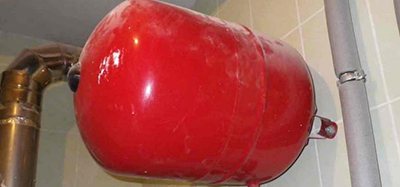
An important part of the heating system is the expansion tank. This is a reservoir for the outlet excess coolant, expanding when heated.
It is impossible without an expansion tank proper functioning any heating system.
Purpose of expansion tank for boilers
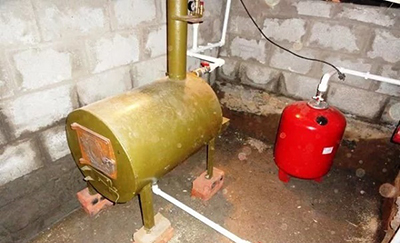
At the moment of heating the volume of any body increases.
This is due to the physical properties of the substance. Liquid bodies, and in pipes and heating radiators these are heat carriers, for every 10 °C of heating increase approximately by 0.3%.
Since liquid cannot be compressed, then its surplus appears, which need to be directed somewhere. For this purpose, an expansion tank is installed.
This device takes excess liquid from heating pipes and replenishes the lack of coolant when it cools and, as a result, is compressed.
Important! In the absence of an expansion tank, during heating of the coolant, increase in pressure, which leads to the rupture of pipes and radiators.
The expansion tank provides safe operation of all heating system components.
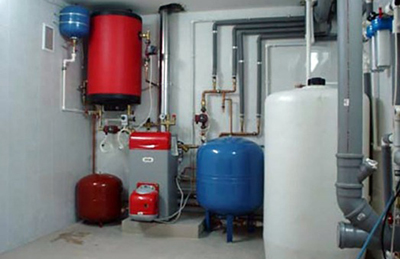
The correct installation depends on service lifeThus, the tank is needed in order to:
- temporarily remove excess coolant from the heating system when it is heated;
- remove excess liquid from the tank when the maximum level is exceeded;
- to replenish the lack of coolant in pipes when it cools down;
- maintain heating system pressure by adjusting the volume of the coolant;
- accumulate and release air and vapor from liquid into the atmosphere, which appear when it is heated.
Types of tanks
Exists two types tanks for heating systems:
- open;
- closed.
Open
It is installed in systems with natural circulation of the coolant. It is mounted at the highest point and is open or semi-open container round or rectangular in shape.
At a certain level, a tube is inserted into it to drain excess coolant. Open tank they definitely insulateso that the coolant does not cool down.
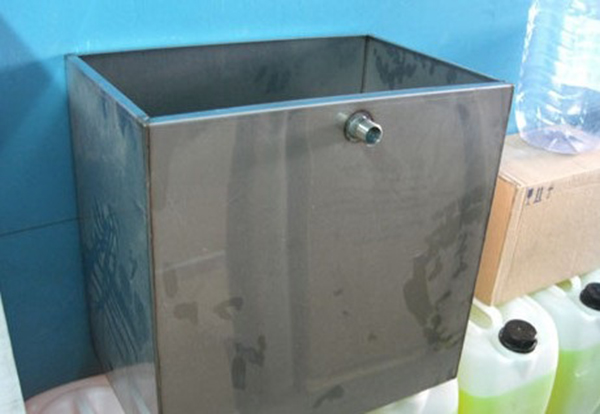
Photo 1. Open type expansion tank, suitable for heating systems with natural circulation.
Advantages:
- simplicity and ease of maintenance;
- lack of additional elements;
- ease of management.
Flaws:
- openness and contact with the atmosphere, as a result of which corrosion of the device itself is possible;
- due to openness it is observed large evaporation of coolant, which leads to the need for constant monitoring of the liquid level;
- installation at the top of the main riser delivers inconvenience when adding liquid to the system.
Closed
A closed-type tank is installed in heating systems with forced circulation of the coolant. It is a sealed container with a Mayevsky tap installed to release excess air. To control the pressure inside the tank, it is equipped with a barometer. Such a tank can be installed anywhere in the room.
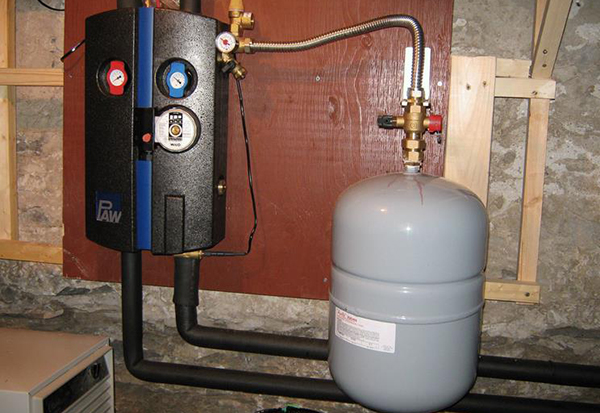
Photo 2. A closed-type expansion tank is usually installed in heating systems with forced circulation.
Advantages:
- complete tightness of the system;
- no contact with air, which eliminates corrosion of pipes and radiators;
- ease of installation;
- economy.
Flaws:
- the need to install additional equipment to control the pressure inside the tank;
- risk of damage to the device due to pressure surges.
Membrane
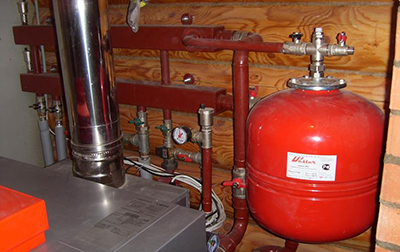
Membrane type tanks - a separate type of closed tanks. They represent a sealed container with an elastic membrane inside.
The membrane serves to regulate the pressure of the liquid in the system. divides the tank into two parts. One part is filled with inert gas, and the other is designed to receive excess coolant.
When liquid enters one part, the pressure on the membrane increases, causing it to shift to the side where the air is. When the coolant cools, the reverse process occurs. The pressure from the liquid side decreases, and the compressed air pushes the membrane back.
Membrane tanks can have replaceable and non-replaceable membrane. In the second case, if it breaks, you will have to replace the expansion tank completely, which is why the first type of tank is more popular.
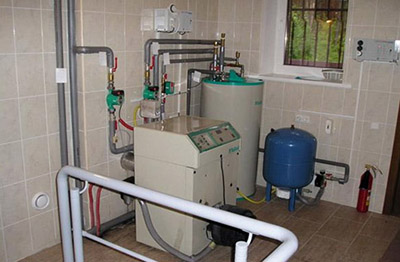
Advantages:
- no contact with air and, as a consequence, preventing metal corrosion;
- installation in any convenient place indoors;
- no need for thermal insulation;
- ease of installation;
- reliability;
- economy, because the coolant does not evaporate from the pipes and radiators and does not cool.
Flaws:
- impossibility to make by hand without special materials and tools;
- periodic checking of inert gas pressure;
- in case of structural failure in certain cases the tank will have to be replaced completely.
Reference! Membrane tanks are installed in closed-type heating systems using pump. Such systems depend on the availability of electrical energy.
How to calculate the volume of the tank
When calculating the volume of the expansion tank, several factors must be taken into account:
- capacity and power of the heating system;
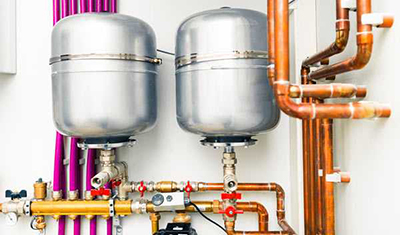
- heating system type;
- type of expansion tank.
To calculate the capacity of the tank, the following formula is used:
Vб=(Vс * K)/D, where:
Vб — tank capacity;
Vс — the volume of coolant in the system;
TO — coefficient of expansion of liquid. For water this indicator is equal to 4%, therefore the formula uses 0.04;
D — the expansion coefficient of the tank itself, depends on the material of manufacture and the temperature difference during heating. To accurately determine "D", you can use the formula:
D = (Pmax - Pinit)/ (Pmax + 1), where:
Pmax — this is the value of the maximum pressure inside pipes and radiators;
Rnach — this is the pressure inside the tank planned by the manufacturers (usually 1.5 atm.).
Thus, the volume of the tank depends largely on its own characteristics.
Attention! All indicators and characteristics should not be above established standards. When calculating the volume of the device, the data should be equal to or slightly greater than the results obtained.
Many sites offer online calculations expansion tanks.
Installation in a private house
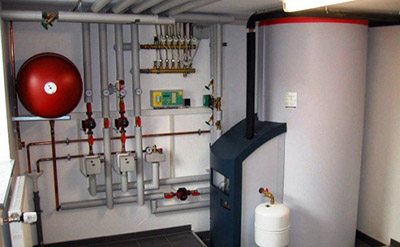
When connecting the tank to the heating of a private house, you should decide on its type. Each type of connection is carried out according to the instructions and has its own characteristics.
Features of connecting an open-type tank:
- installed directly above the boiler at the highest point of the riser;
- the tank body is carefully insulated;
- An emergency liquid drain must be installed.
Important! It is better to direct the emergency drain into the sewer, to prevent living creatures from coming into contact with the hot stream of coolant.
Features of installation of closed and membrane type tanks:
- small containers are attached to the wall using a clamp or hung on a bracket, large ones are installed on the floor;
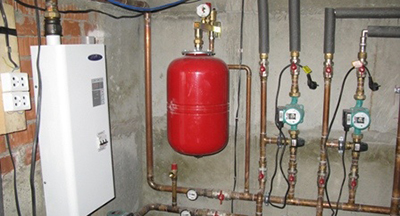
- membrane tanks are best installed vertically, with a horizontal arrangement, penetration of inert gases into the coolant is possible;
- the container should be installed in such a way that so that it is easy to maintain;
- closed expansion tank is installed directly in front of the heating boiler and the pump in the discharge pipe;
- The load from the supply pipes should not fall on the device.
Important! It is prohibited to lay an underwater pipe by gender or hang to the heights.
Correct connection of the expansion device is carried out through the shut-off valve. Thanks to this, the tank can be disconnected from the heating, preventing air from entering the pipes.
Work order
- The container itself is installed and secured. Installation type: floor or wall-mounted - determined by the volume and weight of the tank.
- A cut is made into the return pipe.
- A shut-off valve is screwed onto the thread.
- The pressure is being checked in the heating system.
Useful video
Watch a video explaining how an expansion tank is installed and how to choose a location for its installation.
What kind of tank is needed for the heating system?
The expansion tank for the heating system is selected in accordance with the type it belongs to. If it is an open system, that is, two options: closed or open tank.
In the second case there is also a choice - a conventional closed tank or membrane device.
When choosing a tank, you should take into account the volume of coolant in pipes and radiators, the type and power of the boiler. Based on the calculation results, the volume of the device is selected. It is important to consider the method of its installation when choosing a tank.






It is better for you to take a tank with a reserve of 8 liters.